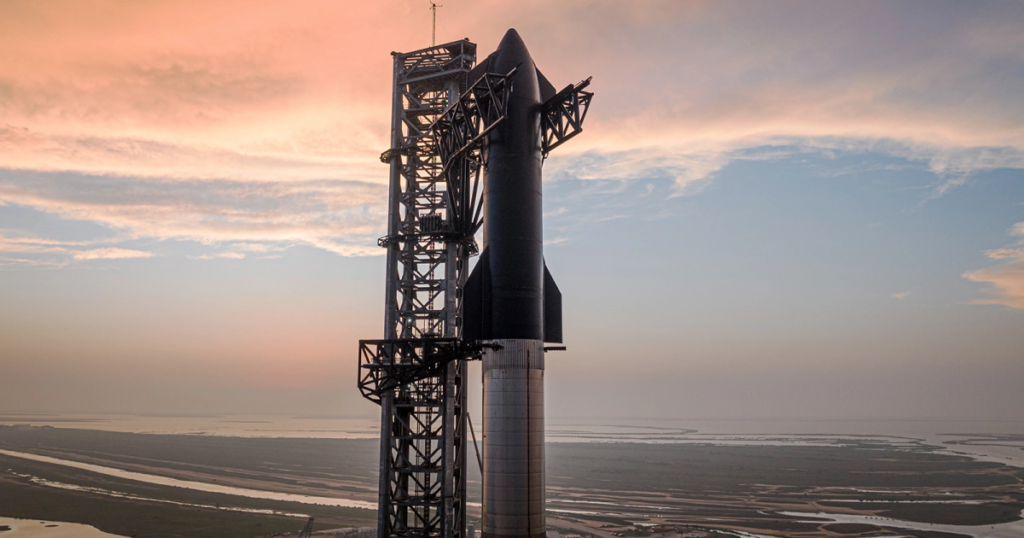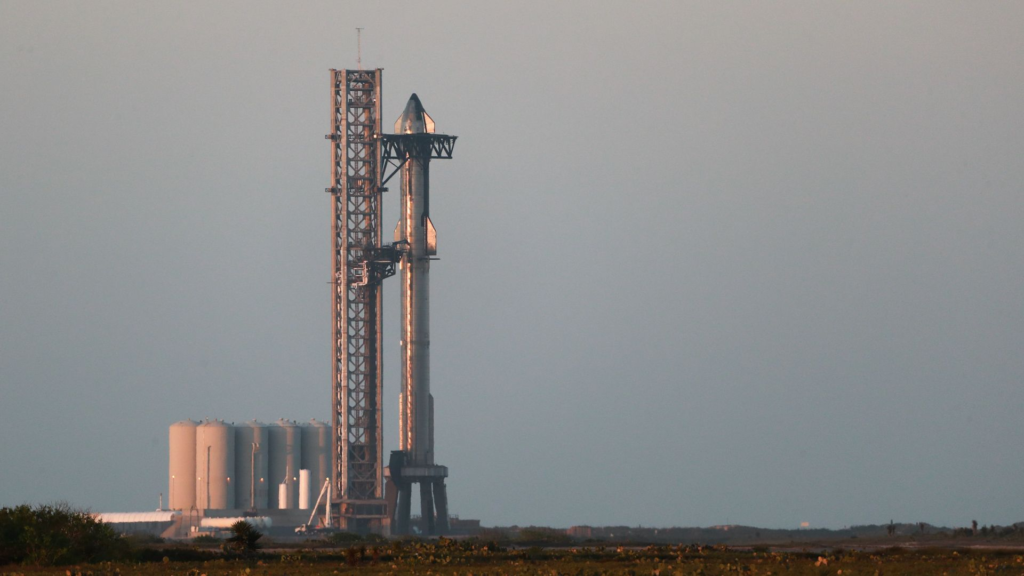
Why SpaceX Launched Starship With Minimal Pad Protection
It’s now been a few days since the historic first test flight of Starship and we are beginning to get a better look at the pad and damage to Stage 0. Refrigerator size concrete blocks were launched into the air and at the surrounding structures. This in combination with the trench created below the Orbital Launch Mount is causing a few concerns for the structure and Starship’s future timeline.
With all of this in mind, it brings up the question of why did SpaceX launch the most powerful rocket in the world over just concrete? In reality, there are a few reasons including wanting to get the launch off as soon as possible, misjudging the impact it would have, and part of SpaceX’s approach to testing new things. All of which convinced the company that launching without a flame diverter and a water deluge system was worth it.
While Starship still managed to fly for minutes and SpaceX gathered a bunch of invaluable data, Stage 0 has seen much better days and requires a decent amount of work. Here I will go more in-depth into SpaceX’s decision, what this means for the next launch, what to expect in the coming weeks, and more.
Minimal Pad Protection

On April 20th Starship lifted off and in the process of clearing the pad destroyed a large portion of the concrete below. This caused somewhat of a domino effect as this destroyed concrete then was shot in every direction flying hundreds of meters. At Stage 0 after the launch, SpaceX was left with a large trench under the Orbital Launch Mount, stripped concrete on the mount supports themselves, dents on the nearby tank farm, and more. All of which left people asking why would SpaceX launch with just this minimal pad protection.
One of the first reasons was time. In the past, while keeping up with Starbase and the Starship program, we have seen parts for both a flame diverter system and a water deluge system. Both of which combine to create a common pad and rocket protection system during launch. They work to both dampen and redirect the insanely hot and powerful exhaust and sound waves produced by the engines. These two systems can be seen across a host of launch pads used for the Falcon 9, SLS, the Space Shuttle, etc. In SpaceX’s case, these systems were not ready to be installed by the time they got the clear to launch. Even Elon confirmed after the launch that these systems had been under construction for months prior to liftoff.
Specifically, on Friday the 14th, the Federal Aviation Administration issued a launch license to SpaceX for the launch of its Starship rocket from South Texas. “After a comprehensive license evaluation process, the FAA determined SpaceX met all safety, environmental, policy, payload, airspace integration and financial responsibility requirements,” the agency said in a statement. “The license is valid for five years.” Only 6 days after receiving this launch license, Starship was in the air.
With this in mind, the company had two options, wait at least a few months to finish constructing the proper systems and then launch Starship when complete (which could be a while), or launch Starship right now with the minimal pad protection in place. It’s also important to point out that it’s possible even if they had all the parts necessary for those various systems, they might have needed certain permits to build it which would have taken even longer. The decision SpaceX made connects to the other main reason they launched with just concrete, they misjudged it. Right after the launch Elon was quoted saying, “3 months ago, we started building a massive water-cooled, steel plate to go under the launch mount. Wasn’t ready in time & we wrongly thought, based on static fire data, that Fondag would make it through 1 launch.” This highlights that the company believed the special heat resistant concrete used below the pad would hold up for at least a single launch. It held up quite well to a 31 Raptor engine static fire months before the launch however that test was only using partial thrust. When the full thrust of Starship contacted the ground for around 8 seconds, the concrete was not able to stay strong.
The final reason has to do with SpaceX’s mindset and testing strategy. While the company knew there were some risks with launching Starship using the current pad infrastructure, they wanted to try and test a very minimal setup under the rocket. SpaceX is known for creating rapid iterations and testing them as soon as they can, gathering flight data, applying it to the next system, and so on. Even though the damage to the pad is far from ideal, SpaceX now has a great example of what exactly the thrust of these engines can do to an extremely solid concrete pad in a short period of time. Something that will most definitely be applied to future launch and landing operations.
Starship’s Future

Right now, crews have returned to the launch pad and are beginning to thoroughly assess the damage and figure out the next steps for the company. Based on the trench and tank farm denting in particular, it’s clear that the pad is going to be the main factor holding back the next launch of Starship using the upgraded Booster 9. A big current question for the company is deciding whether or not the Orbital Launch Mount needs to be replaced. While a lot of the ground under it was destroyed, the mount itself seems to be holding strong.
As teams continue to inspect it, they could decide that the supports and main structure are in good enough condition to just repair rather than replace. This would be the best case scenario and save a lot of time. Before this launch, it took months to set the foundation, fill it with concrete and build up the mount. Not to mention the complexities of its clamp system and other technology.
In regard to the mission the FAA said in a statement, “The FAA is providing oversight to ensure SpaceX complies with its FAA-approved mishap investigation plan and other regulatory requirements. The FAA will review, and must approve, the final report before the mishap investigation can be closed.” While the company is approved for the next 5 years, they still need to get the clear from the FAA after and before Starship launches.
The pad damage also brings up questions relating to the company’s other Starship launch site in Cape Canaveral at launch pad 39A. In 2019, SpaceX began substantial modification to LC 39A in order to begin work on phase 1 of the construction to prepare the facility to launch Starship. In August 2019, SpaceX submitted an Environmental Assessment for the Starship launch system at Kennedy Space Center. This document included plans for the construction of additional structures at LC-39A to support Starship launches, including a dedicated pad, liquid methane tanks, and a Landing Zone. These are separate from the existing structures that support Falcon 9 and Falcon Heavy launches. In December 2021, Elon Musk announced that SpaceX has started construction of a Starship orbital Launchpad at the Cape. On June 16, 2022, the first integration tower segment for the Starship orbital pad arrived at LC-39A. Stacking began on June 21, and the Starship launch mount is also under construction.
So far this pad and tower have been built up almost identically to the pad in Texas where Starship just launched. Obviously, before Starship begins to take off from that site, SpaceX will need to create a system that not only protects the rocket itself but also stops debris from flying in every direction. That site is right next to another launch pad with a proper flame diverter and water deluge system. Not to mention the proximity to other launch pads on at the Cape. In the future, once SpaceX has created a proper solution that works in Texas, they will implement that at the launch site in Florida.
The main plan for Starship is to use Boca Chica and Starbase as a rapid build and test site where the company can blow up rockets and damage surrounding structures if necessary. They see the Texas site as an initial testing grounds but Launch Pad 39A as the future of Starship operations. Here we can expect consistent launch operations once the rocket has proven itself as a reliable and capable system. However, before this, the company has a lot of work to do. While Elon gave an estimate of 1 to 2 months before the next launch, it’s likely going to be much longer than that. We could be facing a 4 to 6 month delay and possibly longer based on all the damage. It will depend on the integrity of the Orbital Launch Mount, tank farm, and some other surrounding infrastructure.
As for the next launch, it should have a bunch of improvements in many different ways. Not only is the next Starship prototype significantly upgraded and features a hot of design changes, but the pad will be at least better than the first launch which could impact the flight. The ejection of concrete could have damaged the rocket itself, something that should be avoided on the next attempt. We will have to keep up with the company’s progress in the next few months as they prepare for a second launch.
Conclusion
After a very event full first launch, SpaceX is now in the process of determining the next steps for both the Starship rocket and Stage 0. They will need to rebuild and repair any damage to the pad and if they are lucky, the Orbital Launch Mount won’t need to be replaced. If so, it could be a while before we see Starship lift off again as extensive work changes the design and look of Stage 0. We will have to wait and see how it progresses and the impact it has on the space industry.